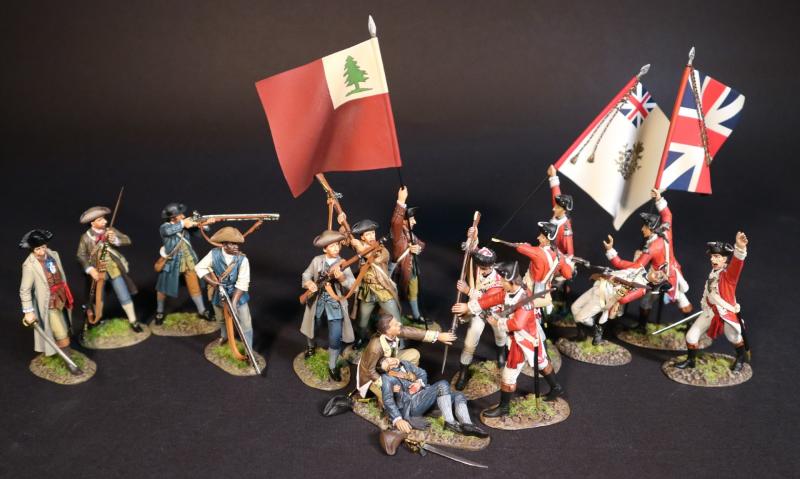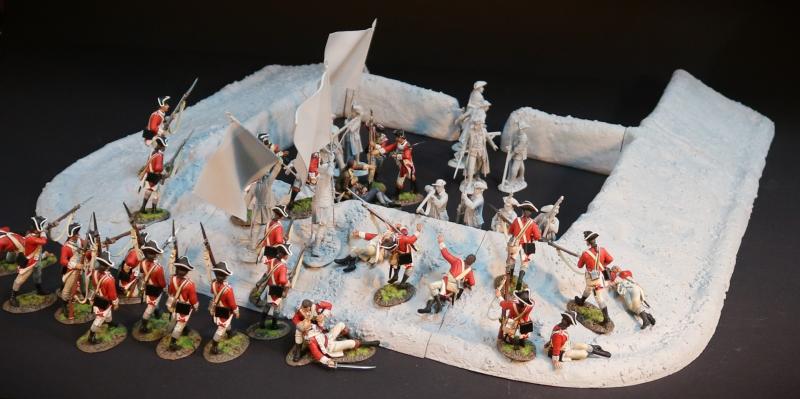The Death of General Warren, The Assault on the Redoubt at Breeds Hill, The Battle of Bunker Hill, June 17th 1775, The American War of Independence, 1775–1783--two figures on single base, two hats, sword
$98.00
Item Number: ABHL-14
The Death of General Warren, The Assault on the Redoubt at Breeds Hill, The Battle of Bunker Hill, June 17th 1775, The American War of Independence, 1775–1783
Boston was the third largest town in North America, and stood on a Peninsula connected to the mainland by a neck just wide enough to cross at high tide. The harbour, large enough to be strategically significant, and central to the town’s economy, was formed by a chain of islands stretching out to sea, guarded by reefs and ledges. North west of Boston was Charlestown, a largely rural peninsula one and a half miles long. Charlestown stood at the south east corner with three hills behind it: Bunker’s Hill, nearest the neck of the Peninsula; Breed’s Hil,l 200 yards above the town; and Moulton’s Hill to the north east.
On the 16th June 1775, 3 detachments from Massachusetts regiments under the command of Colonel William Prescott and engineer Captain Richard Gridley, crossed the Charlestown neck and arrived at Bunker Hill. Captain Richard Gridley and Prescott disagreed as to where they should locate their defense. Some work was performed on Bunker Hill, but Breed’s Hill was closer to Boston and viewed as being more defensible, and they decided to build their primary redoubt there. Prescott and his men began digging a square fortification about 130 feet a side with ditches and earthen walls. The walls of the redoubt were about 6 feet high.
Work began at midnight, and around 4am one of the British warships spotted the earthworks on Breed’s Hill and opened fire. The British command agreed that the works posed a significant threat, but were at this time sufficiently incomplete and isolated to offer a chance of a successful attack.
The original British plan was to bypass the redoubt to the north and capture Bunker’s Hill and the neck of the peninsula, thus isolating the redoubt on Breed’s Hill.
The Americans repulsed two British assaults, with significant British casualties. The British captured the redoubt on their third assault, after the defenders had run out of ammunition. The colonists retreated over Bunker Hill, leaving the British finally in control of the Peninsula.
The battle was a tactical victory for the British, but it proved to be a sobering experience for them; they incurred many more casualties than the Americans had sustained, including many officers. The battle had demonstrated that inexperienced militia were able to stand up to regular army troops in battle. Subsequently, the battle discouraged the British from any further frontal attacks against well defended front lines. American casualties were much fewer, although their losses included General Joseph Warren, and Major Andrew McClary, the final casualty of the battle.
THE DEATH OF GENERAL WARREN
The Death of General Warren set is inspired by the paintings of the American artist John Trumbull.
Warren was an influential Massachusetts physician and politician, who had been commissioned as a general, but served in the battle as a private. He was killed during or shortly after the storming of the Breed’s Hill redoubt by a British officer.
Artist John Trumbull (1756-1843) was in the colonial army camp at Roxbury, Massachusetts on the day of the battle of Bunker Hill. He watched the battle unfold through field glasses, and later decided to depict one of its central events in several oil paintings. The paintings are iconic images of the American Revolution. Trumbull painted several versions, one is on view at the Museum of Fine Arts in Boston (dated between 1815 and 1831). This version was commissioned by the Warren family and passed down through the family before being acquired by the museum.
Another larger version (dated 1834) is held by the Wadsworth Atheneum in Hartford, Connecticut.
Released in NOVEMBER 2024.


